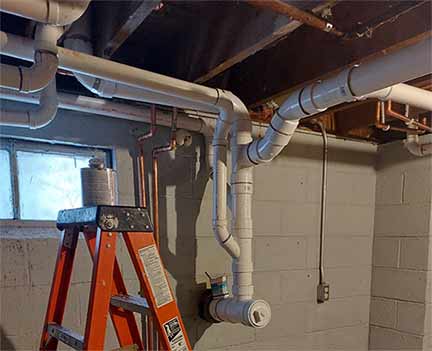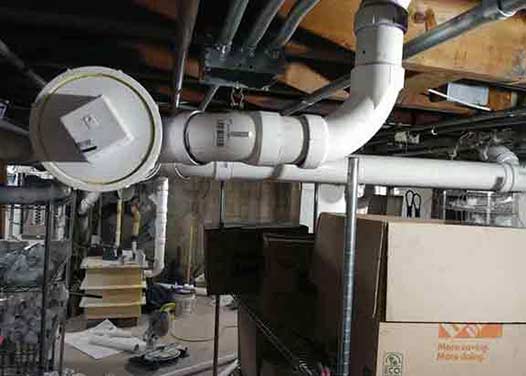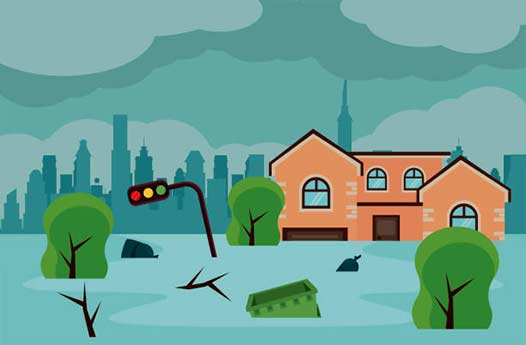The Problem of Flooding in Chicagoland
Chicagoland, with its sprawling urban landscape and heavy rainfall, is no stranger to the issue of flooding. Over the years, the city and its surrounding areas have suffered the consequences of heavy rainfall, leading to property damage, financial losses, and tremendous inconvenience for its residents.
The traditional sewer systems in Chicagoland, known as combined sewer systems, were designed to handle both stormwater runoff and wastewater from homes and businesses. However, during periods of intense rainfall, these systems often become overwhelmed, leading to backups and flooding. This is where overhead sewer systems come into play as a sustainable solution to mitigate the impact of flooding in the region.
What are Overhead Sewer Systems?
An overhead sewer system is an alternative to the conventional combined sewer system. Unlike a combined sewer system, an overhead sewer system keeps stormwater and wastewater separate, thus reducing the likelihood of backups and flooding during heavy rain events.
The primary feature of an overhead sewer system is the installation of an overhead sewer pipe in the basement or crawlspace of a building. This pipe collects wastewater from the various plumbing fixtures, such as sinks, toilets, and showers, and directs it to the municipal sewer system.
Additionally, an overhead sewer system incorporates a sump pump that automatically activates when water levels reach a certain threshold, ensuring that any excess stormwater is pumped out and away from the building. This prevents flooding and damage to the property.

With an overhead sewer system, homeowners and businesses can safeguard their properties from the damaging effects of flooding.
The Advantages of Overhead Sewer Systems
1. Flood Prevention: By keeping stormwater and wastewater separate, overhead sewer systems greatly reduce the chances of flooding during heavy rainfall. This is particularly important in low-lying areas and regions prone to frequent or severe storms.
2. Property Protection: Flood damage can be devastating and costly. With an overhead sewer system, homeowners and businesses can safeguard their properties from the damaging effects of flooding. This can significantly reduce repair and restoration costs, as well as insurance premiums.
3. Basement Usage: Basements become usable and safe spaces when protected by an overhead sewer system. Homeowners can convert their basements into living spaces, recreation rooms, or storage areas, without the constant worry of water damage and flooding.
4. Environmental Benefits: Overhead sewer systems help to prevent the overflow of untreated wastewater into local water bodies during heavy rain events. By reducing the strain on the municipal sewer system, these systems contribute to cleaner and healthier waterways.
5. Long-Term Cost Savings: While the installation of an overhead sewer may require an upfront investment, the long-term cost savings can be significant. The prevention of flood damage and associated repair costs can outweigh the initial installation expenses.
The Installation Process
Installing an overhead sewer system in an existing building involves a series of steps carried out by a professional plumbing service provider. The process generally includes the following:
1. Assessment and Planning: A thorough assessment of the property is conducted to determine the feasibility of installing an overhead sewers. The contractor evaluates the existing plumbing layout and identifies the most suitable location for the overhead sewer pipe and sump pump.
2. Excavation: In order to install the overhead sewer pipe, excavation may be required in the basement or crawlspace area. The contractor carefully digs the necessary trenches to accommodate the new pipe and sump pump system.
3. Pipe Installation: The overhead sewer pipe is installed, connecting the existing plumbing fixtures to the municipal sewer system. The pipe is positioned at a higher elevation, ensuring that wastewater flows downward and away from the building.
4. Sump Pump Installation: A sump pump system is installed to remove any excess stormwater collected in the basement or crawlspace. The sump pump activates automatically, preventing water from accumulating and causing flooding.
5. Testing and Inspection: After the installation is complete, the system is thoroughly tested to ensure proper functionality. Any necessary adjustments or repairs are made, and a final inspection is conducted to ensure compliance with local building codes.

By separating stormwater and wastewater, these systems help prevent backups, protect properties, and enhance the overall livability of homes and businesses.
Considerations for Chicagoland Residents
While overhead sewer systems offer numerous benefits for flood-prone areas like Chicagoland, it is important for residents to consider a few factors before making the decision to install such a system:
1. Cost: The installation of an overhead sewers can involve a significant initial investment. It is essential for homeowners to obtain multiple quotes and consider the long-term cost savings in flood prevention and property protection before making a decision.
2. Property Characteristics: Depending on the layout and condition of the property, the installation process of an overhead sewer system may vary. Speaking with a licensed plumber in Chicago is crucial to assess the feasibility and requirements specific to each property.
3. Maintenance: Like any other system, overhead sewer systems require regular maintenance to ensure optimal performance. Homeowners should be prepared to schedule periodic inspections and cleaning of the system, as well as occasional repairs or replacements.
4. Local Building Regulations: Before proceeding with the installation of an overhead sewer system, homeowners should familiarize themselves with local building codes and regulations. This ensures compliance and prevents any potential issues during and after the installation process.
In Conclusion
Overhead sewers present a sustainable and effective solution for combating flooding in flood-prone areas like Chicagoland. By separating stormwater and wastewater, these systems help prevent backups, protect properties, and enhance the overall livability of homes and businesses.
Residents in Chicagoland should consider the advantages of overhead sewer systems, weigh the costs and benefits, and speak with professional plumbers to determine the feasibility and requirements for their specific properties. By investing in an overhead sewer system, homeowners can create peace of mind and mitigate the risks associated with flooding, ensuring a safer and more sustainable future for the region.
